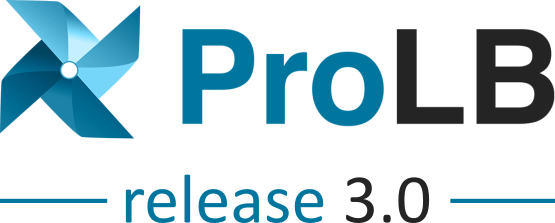
New LBM collision model (named HRR for Hybrid Recursive Regularized), developed in partnership with M2P2 lab (Aix-Marseille University):

Older versions of LBPre .labs files can be opened in this version and will be automatically updated using our lbrecover tool. When necessary, a backup copy of the original file will be done for safety so that you never loose your setup.
You can now define a folder as a “templates folder”, using an environment variable. Any .labs file placed in this folder can be used as a template for LBPre 3.0.
The linked items setup is no longer boundary specific:
We extended LBPre capabilities, adding features and making it smarter to ease your setup:
The user manual is now part of the ProLB documentation, together with LBsolver manual. This documentation is available in html format and takes advantage of browser functionality :
New shortcuts are available for better 3D navigation
New viewport functions were added :

The previous in-house Double Relaxation Time (DRT) collision model was replaced by the new Hybrid Recursive Regularized (HRR) collision model [1]. This innovative collision model is better than the DRT on several aspects. It relies on the modification of previously existing recursive regularised BGK models, which consists of hybridising the computation of velocity gradients. The resulting effect is the introduction of a stabilising hyperviscosity term, whose amplitude can be explicitly tuned via a control parameter. This well-controlled hyperviscosity term allows to improve the overall stability of the ProLB simulations. One direct benefit is to be able to increase the time-step value and thus to reduce the simulation time.
[1] Jacob, Jerome & Malaspinas, Orestis & Sagaut, Pierre. (2018). A new hybrid recursive regularised Bhatnagar–Gross–Krook collision model for Lattice Boltzmann method-based large eddy simulation. Journal of Turbulence. 19. 1-26. 10.1080/14685248.2018.1540879using a hybrid solver approach :
Our Optimal Surface Resolution algorithm was improved to be more robust. The OSR allows to re-mesh the output surfaces in order to have nearly the same spatial resolution as the volume mesh resolution. It does not impact physical algorithms themselves: it is only applied on the output mesh.
3 schemes are now available in ProLB 3.0 :
The user can also access previous schemes (D3Q19DRT and D3Q19DRTTherm) but they are now considered as legacy.
We developed with our partners a new mesh transition algorithm to handle the reconstruction of distribution functions, called Direct Coupling (DC) algorithm [1]. In some configurations, the DC algorithm reduces the small spurious errors on the small-scale turbulence vortices due to sudden change in mesh resolution.
[1] Astoul, Thomas & Wissocq, Gauthier & Boussuge, Jean-François & Sengissen, Alois & Sagaut, Pierre. (2021). Lattice Boltzmann method for computational aeroacoustics on non-uniform meshes: A direct grid coupling approach. Journal of Computational Physics. 447. 110667. 10.1016/j.jcp.2021.110667We have developed a unique and advanced surface mesh algorithm that resolves intersections between some predefined surfaces of the model, hence its name : surface sewing algorithm. It generates proper wet surfaces of the model, including in very concave regions, and is useful to get accurate integrated quantities.
Unlike well-known wrapping techniques, our sewing algorithm locally calculates the intersection between surfaces and adds some triangles along the intersection line. The initial user topology is then rigorously maintained.
Which resulted in a 20% CPU time reduction compared to v2.8 HRR beta version
We now focus on the integration of the fully compressible high Mach scheme. This integration is made using a hybrid coupled solver approach :
The beta version is planned for this year, stay tuned!